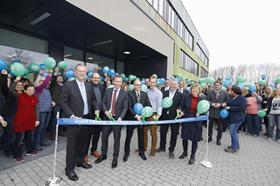
Bayer is aiming to consolidate its position in the global pest control market by investing some €45m in the construction of an 11,000m2 greenhouse at its Monheim site, with an adjoining laboratory and office building for insecticide research.
'The new building will help us overcome one of the fundamental challenges of our times: safeguarding the global supply of food,' said Dr Dirk Backhaus, head of product supply and member of the executive committee of Bayer's Crop Science Division. 'This greenhouse could have been built anywhere in the world. But Germany has substantial advantages as a location: diverse, sustainable agriculture, a high level of education, and a solid knowledge base as well as being attractively situated in a dynamic European environment.'
As such, the investment also reflects Bayer's commitment to the innovative capacity of Europe, Germany, and specifically to the Monheim research site in North Rhine-Westphalia, he noted.
The construction of the new greenhouse is Bayer's largest single project in Monheim in an investment programme that has totalled around €170m over the past six years.
Aside from new investments, key elements of the growth strategy for the Crop Science division include the modernisation and targeted expansion of the existing research infrastructure.
Backhaus stressed the need for societal support for industrial research. 'We are living in times in which populism and political polarisation are endangering the acceptance of modern science,' said Backhaus, citing recent emotionally charged campaigns such as the one against important insecticidal substance classes like the neonicotinoids, the debate surrounding the reauthorisation of glyphosate and the media response to reports on the decline in insect populations in some parts of Germany.
'Insects are of huge significance to Bayer due to their important role as pollinators of many crops,' he continued. 'Our task is to engage the public in an open and transparent dialogue about the innovative solutions that we at Bayer are developing to improve the quality of human life and thus bridge the gap between producers and consumers.'
Farmers across the world are increasingly facing new pest infestations and mounting resistance to currently available insecticides. Furthermore, tighter regulations result in higher entry barriers for new insecticidal solutions.
As such, state-of-the-art research with outstanding technological capabilities is a key factor for the successful development of crop protection innovations, especially insecticides.
'The new greenhouse will improve our ability to develop new selective insecticides,' noted Dr Markus Dollinger, head of insecticide research at Bayer. 'We are confident that the innovative products based on the active ingredients that will be developed here will meet the urgent needs of our customers while at the same time supporting sustainable agriculture.'
In addition to the greenhouse, an adjacent building with 1,200m2 of laboratory space and 870m2 of office space will also be available for insecticide research.
The greenhouse will provide 60 employees with optimal conditions for cultivating and testing over 30 different crop species and over 40 in some cases exotic pests and beneficial organisms.
The facility consists of 133 compartments, in which a wide variety of climate conditions can be individually replicated, such as temperature, humidity, length of day, temperature curves, and air filtration. This will allow experiments to be conducted under realistic conditions similar to those found in nature. I
Bayer says it will be possible to conduct parallel studies on native and exotic crops using active ingredients currently in development and alternative technologies such as biological crop protection, plant breeding and beneficial-compatible combination strategies.



